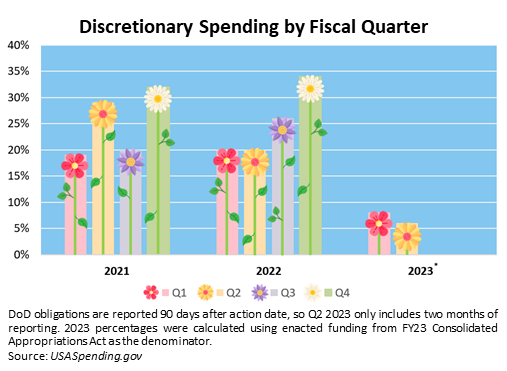Selling Season vs. The Debt Ceiling Drought
- “Selling season” is upon us – the time of year when agencies have to dole out the balance of their current fiscal year funding
- Historically, the government obligates the plurality of its budget in Q4, so this is the window to get actionable projects in front of buyers
- In addition to “shovel ready” projects, maintain a cornucopia of contract vehicles so that buyers can choose how to reach you
- Compared to FY21 and FY22, FY23 is in like a lamb and out like a lion, with light Q1/Q2 spending presaging a historically large Q3/Q4
- Debt ceiling default could mean a halt on payments for contractors and could make it very difficult for the government to make new awards
- Don’t sell your crop futures yet – DC weather changes frequently – get out there, sow your seeds, and hope the weather turns favorable
Historic Crop Reports
With the same predictability as the seasons changing, the federal government requires agencies to obligate their funding on programs, products, services, solutions, and other items right around this time of year, every year. Most discretionary spending requests must be “in the process” with federal acquisition officials by a July deadline to enable ultimate obligation of funds by September 30. We call this time of the year selling season, because we know the government must put into writing the who, what, when, where, how, and how much they intend to spend this FY. This cyclicality results in a flurry of RFPs and other procurement actions as contract shops scramble to get it done in time. Industry also swings into action to get their solutions in front of customers in time to make the cut. The net result is a tendency to commit the plurality of funding obligations in Q4 of each government fiscal year, as is shown in the graphic to the right.
Seed Sowing Best Practices
If you are not prepared for the selling season storm, you may find yourself cleaning up the debris of missed opportunities in the months or even years to come. It may seem daunting, but opening an umbrella of best practices can help you better weather the storm. Prepare your proposal artifacts well in advance of agencies’ deadlines, invest in “shovel ready” solutions, and make sure customers can access you via their preferred vehicle. Increasing contract ceiling is the easy button for obligations, so socialize that and ensure you have sufficient remaining period of performance. Kick off projects now so that they can continue, despite the outcome of the debt ceiling negotiations. If the Treasury must reduce spending as a result of fiscal externalities, they may prioritize funding certain agencies/programs/projects over others, including certain mandatory programs. Strong relationships can be fertilizer through uncertain times so find teaming opportunities with organizations that have established relationships (or who might be considered agency “favorites”) inside target customers.

Consulting The Farmer’s Almanac
Meteorologists are predicting that we could see a different spending pattern this year because of the debt limit crisis. Q1 spending has been relatively flat over the last three years. While Q2 saw a large spike in FY21, Q4 is consistently where we see the healthiest harvest with spending reaching its peak. FY22 was an extreme example due to the late passage of the budget. Given the slow start to the year, FY23 was shaping up to be the biggest year end in quite some time. The debt limit crisis could be the drought that wipes out the whole harvest. A debt default would temporarily halt federal spending and with the June 1 action date, contractors could experience stop payments on current work and stagnant new awards. On the other side, Q4 might be the harvest of a decade if the debt ceiling is resolved and there is a rush to get money out the door. This would equate to appropriating three quarters of the budget in the remaining third of the year.
Drought, Hail, and Locusts
In January, the US reached the statutory debt limit. Since then, the Treasury Department has utilized short term measures to delay potential default. If the Treasury is unable to continue these short-term delays, the fallout from a default would be unprecedented. Across the entire federal government, the focus would shift to payments to bond holders, then payroll for government employees and essential employees, and funding for critical programs. On May 1, Secretary of the Treasury Janet Yellen wrote to Congress, warning that the default can happen as soon as June 1. In response, the government has floated a wide range of ideas including the idea of issuing a trillion-dollar coin to temporarily absolve the debt ceiling. More conventional measures include capping discretionary spending, creating new committees to reform existing spending programs, or increasing revenues through greater taxation. If the debt limit is not increased in time, agencies would have to make cutbacks which, among other things, could decimate the FY23 federal appropriations crop.
Best Practices to Grow your Garden During Selling Season
- Compile marketing materials, white papers, proposals, and other artifacts early to avoid last minute scrambles
- Stay aware of agency trigger dates, windows, and deadlines as some operate on different schedules
- Leverage agency relationships: know what solutions they are looking for and tailor your capabilities to see where they address or can be adapted to meet mission needs
- Be ready to showcase a large catalog of capabilities – oftentimes agencies have trouble allocating money this time of year if the projects are not “shovel ready”
- If you miss a window, continue working your established pipeline and seek alternatives to get your solutions on contract
- Monitor debt ceiling negotiations and agency directives as their actions can vary widely as was the case with shutdowns and COVID responses
- Do not neglect your post-September pipeline, as the selling season should supplement, not replace, your current pipeline with shutdowns and COVID responses
- Limit lengthy summer vacations for proposal staff and be ready for compressed schedules
Jessica Butturff
703-786-1841
Jessica.Butturff@dwpassociates.com
Jonas Marrello
631-398-0502
Jonas.Marrello@dwpassociates.com
Kelly Moore
757-510-1111
Kelly.Moore@dwpassociates.com



